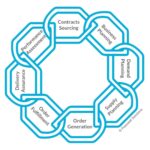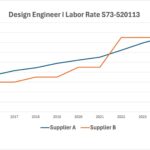The “order generation” and “order fulfillment” links in the supply chain are where most companies are strongest in the supply chain cycle. This is where the supply chain team cuts purchase orders, commits to purchases with suppliers, and coordinates inbound logistics.
Order Generation
Supplier production planning and purchase orders compose the order generation link, and many consider this link to be the heart of what the supply chain does. However, note that it only came in as the fifth link we discuss in our cycle. While it is a cycle and can start anywhere, purchase orders and securing production require foundational steps to be successful.
Supplier Production Planning
The external component of order generation is often overlooked. This is where a company secures scarce production capacity, and should be before the purchase order is officially cut. Communicating what a company is expecting to purchase even outside of lead times can help a supplier secure their raw materials at the best price, schedule the demand into their own production, and anticipate issues the company hasn’t considered. Especially for highly engineered or custom materials, the company may have a preliminary idea of what will be needed, but the detailed specifications and decisions are still finalizing. Clear communication of upcoming demand strengthens the supplier partner aspect of the relationship, and can help both parties reduce risk and cost. Especially for custom materials, the company must do everything it can to communicate the level of certainty with a supplier to avoid rework or excess manufacturing.
Order Generation
A purchase order is a contract. While most supply chain professionals I have interacted with know this, it is easy to forget because it is such a small, everyday contract. We don’t think about generating hundreds of material purchase agreement terms every month, but think nothing of cutting dozens or hundreds of purchase orders every month. Just as changing a contract requires considerable effort and the written acknowledgement of both parties, a purchase order should be similar. Contracts have a force majeure clause to cover events beyond the parties’ control, and those events happen with purchase orders. However, companies should do their best not to change purchase orders once cut, as they are a written commitment to purchasing those goods or services at a specified price. Similarly, suppliers should do their best to meet the terms of the purchase order as written.
Order Fulfillment
The order fulfillment link is where the literal rubber hits the road. This link is all about inbound and intra-company logistics. While the supply chain is sometimes responsible for the outbound logistics of finished goods, I consider that part of the sales cycle instead of the supply chain cycle and so have left it out of scope.
Inbound Logistics
Inbound logistics are the flow of goods from suppliers onto company-controlled property. It can be a common mistake to leave this component of a company’s supply chain in the hands of suppliers. If suppliers are large distributors with their own trucking network always shipping full truck loads to a company, it can be the right answer to have them manage logistics. However, this is seldom the case and instead multiple suppliers ship partial truck loads using a variety of carriers and no coordination. Partial truck loads are considerably more expensive to ship than full truck loads, so without anyone coordinating and consolidating loads companies spend more than needed to ship the same material. Running an RFP to find a solid third-party logistics (3PL) firm partner usually saves 1-2% on spend (25-75% on logistics costs) and results in fewer lost shipments. A great 3PL will also work to set up regular deliveries from key suppliers to spread shipments through the week so warehouses don’t get overwhelmed by large shipments to receive in on Mondays and Fridays.
Distribution Logistics
Distribution logistics, also known as intra-company logistics, are the internal side to the order fulfillment link. This is the flow of material between company-controlled sites, and is often forgotten alongside the giant that is inbound logistics. With distribution logistics, the customer is fully internal, and so complaints about poor process flow or late deliveries are easier to ignore. Whether handled by a company-owned fleet or an external supplier, the key on distribution logistics is to consider it an important part of order fulfillment. The supply chain has not completed its responsibilities until the required good or service is in the hands of the final company team member who needs it, regardless of the internal motion required to get it there.
Our last article in this series on the supply chain cycle next week will discuss the “feedback loop” in supply chain – Delivery assurance and performance assessment. These two links drive the flywheel of improvement and help prevent the constant repetition of the same supply chain mistakes.



